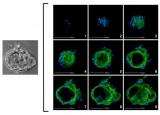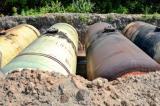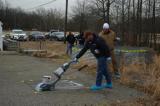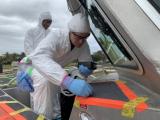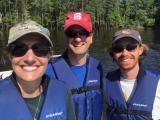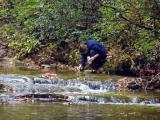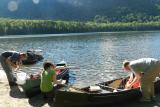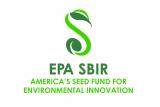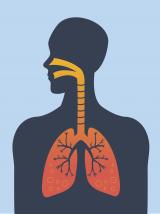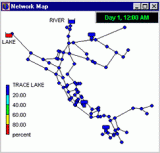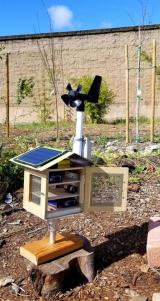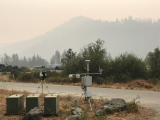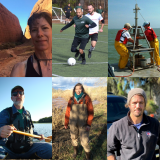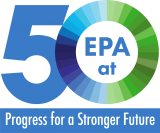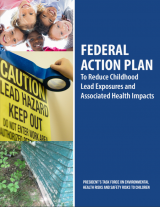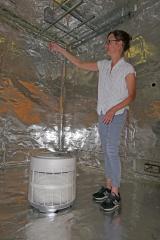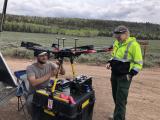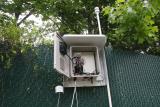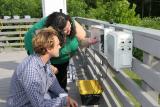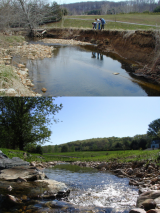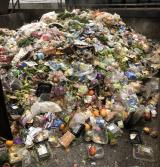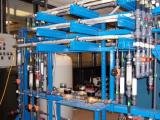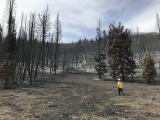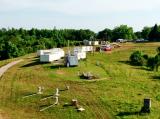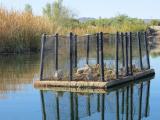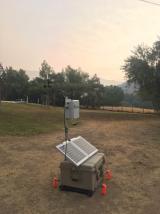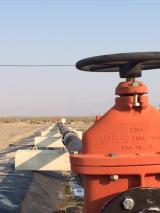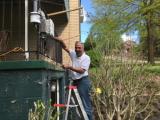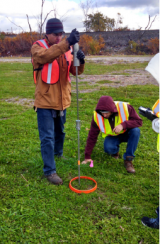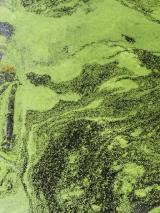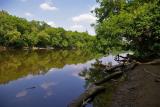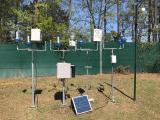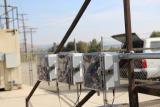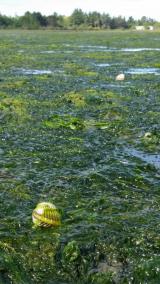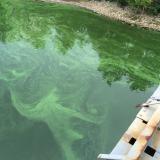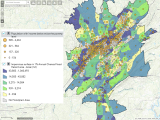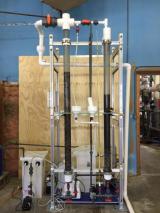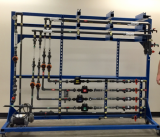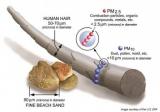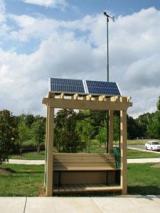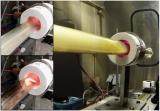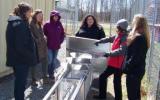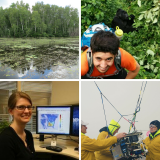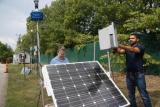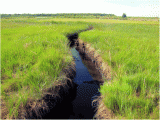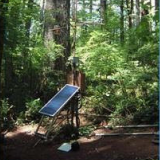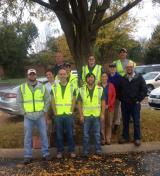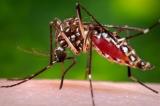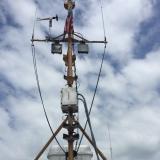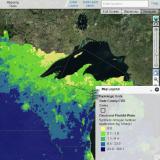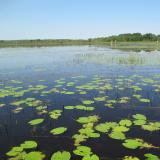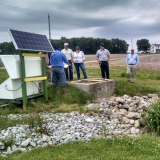EPA Science Matters Newsletter
EPA's Science Matters newsletter delivers the latest from EPA's Office of Research and Development straight to your inbox. Keep scrolling to read recent stories. Sign up to receive the newsletter.
EPA’s Dr. Johanna Nyffeler Awarded 2020 Young Researcher Lush Prize for Efforts to Limit Animal Testing
December 15, 2020 - EPA Postdoctoral grantee Dr. Johanna Nyffeler has been awarded a 2020 Young Researcher Lush Prize in recognition of her efforts to decrease the use of animal testing. Dr. Nyffeler's research uses new approach methods (NAMs) to rapidly test the biological activity of environmental chemicals in human-derived cells. Read EPA’s Dr. Johanna Nyffeler Awarded 2020 Young Researcher Lush Prize for Efforts to Limit Animal Testing.
Answering the Call: EnviroAtlas Team Supports Teachers and Educators during the COVID-19 Pandemic
December 15, 2020 - EPA’s EnviroAtlas team has been helping educators adjust to teaching in the virtual environment. The team worked with teachers and education-focused organizations to not only get educators up to speed on EPA’s existing online educational resources, but also to adapt lesson plans for complete virtual use to meet the new demand. Read Answering the Call: EnviroAtlas Team Supports Teachers and Educators during the COVID-19 Pandemic.
EPA Releases Updated SeqAPASS – Version 5.0 – With Improved Functionality
December 15, 2020 -EPA has released the fifth iteration of the Sequence Alignment to Predict Across Species Susceptibility (SeqAPASS) online tool. SeqAPASS was developed to understand how different chemicals interact with organisms at the molecular level and across species. EPA researchers continue to improve the tool in response to user feedback. Read EPA Releases Updated SeqAPASS – Version 5.0 – With Improved Functionality.
50 Years of Drinking Water Research
December 2, 2020 - For nearly 50 years, EPA scientists have done research to protect America’s drinking water. EPA researchers continue to meet new challenges, such as algal toxins from harmful algal blooms (HABs) and per- and polyfluoroalkyl substances (PFAS). Read 50 Years of Drinking Water Research.
Reflecting on 50 Years of EPA Research: Dr. Mike Slimak
December 2, 2020 - Dr. Mike Slimak is the National Program Director of the Sustainable and Healthy Communities Research Program in EPA’s Office of Research and Development. In honor of EPA’s 50th anniversary, Mike is reflecting on his career at EPA which began in 1978. Read Reflecting on 50 Years of EPA Research: Dr. Mike Slimak.
EPA Researchers Study Aerosol Transport and Mitigation Measures to Reduce COVID-19 Transmission
November 10, 2020 - As we learn more about the virus that causes COVID-19, there is mounting evidence that aerosols are playing a role in transmission of the disease. EPA researchers are looking at how aerosols spread indoors and investigating technologies that could reduce the amount of virus transmitted. Read EPA Researchers Study Aerosol Transport and Mitigation Measures to Reduce COVID-19 Transmission.
EPA Scientists Model Human Systems to Understand Children's Environmental Health Impacts
November 10, 2020 - Children’s health is at the forefront of EPA’s research to protect human health and the environment. In order to reduce potential developmental disorders caused by chemical exposure, EPA researchers are using virtual tissue models to understand a chemical’s effects on developing embryos. This information will help fill data gaps associated with a chemical’s hazard profile and inform efforts to predict chemical effects. Read EPA Scientists Model Human Systems to Understand Children's Environmental Health Impacts.
EPA Develops National Picture of Underground Storage Tank Facilities and Leaking Underground Storage Tank Sites
November 10, 2020 - In the United States, there are more than 500,000 underground storage tanks (USTs) storing petroleum and other hazardous substances. If not properly managed, leaks or spills of these substances can contaminate the surrounding soil and groundwater. EPA created a web-based mapping tool that locates nearby USTs to help states prioritize clean-ups and assess potential vulnerabilities to human health and the environment. Read EPA Develops National Picture of Underground Storage Tank Facilities and Leaking Underground Storage Tank Sites.
Helping to Engage Proctor Creek Community Members as Stewards of Their Watershed
October 27, 2020 - Proctor Creek is an impaired waterway in Atlanta, Georgia, that experiences several overlapping environmental issues. EPA recently collaborated with Proctor Creek residents and stakeholders to develop the Proctor Creek Watershed Story Map, which provide resources and share important information about the Proctor Creek watershed and the role that green infrastructure can play in the community. Read Helping to Engage Proctor Creek Community Members as Stewards of Their Watershed.
Improving Public Access to EPA’s Science
October 14, 2020 -EPA has recently improved two online resources for accessing the science produced by EPA scientists and engineers. The resources are the Science Inventory, a searchable database of more than 80,000 EPA reports, publications, and presentations, and the Science Models and Research Tools (SMaRT) Search inventory of tools that includes ORD science products. Read Improving Public Access to EPA’s Science.
EPA Model Shows Potential in Unraveling the Mystery of Lightning’s Impact on Air Quality
September 28, 2020 -How does lightning contribute to air pollution? EPA researchers simulated the impact lightning has on ground-level ozone across the continental United States. This research will ultimately aid states in efforts to help protect our air quality. Read EPA Model Shows Potential in Unraveling the Mystery of Lightning’s Impact on Air Quality.
EPA Researchers Design Virtual Reality Software to Prepare Responders for Sampling in A Hazardous Environment
September 28, 2020 - When it comes to preparing for environmental sampling after a biological incident, nothing beats hands-on experience. EPA researchers developed virtual reality software for emergency responders to practice environmental sampling in a simulated real-world setting and get the firsthand experience needed to ensure they’re ready if disaster strikes. Read EPA Researchers Design Virtual Reality Software to Prepare Responders for Sampling in A Hazardous Environment.
DIY Air Sensor Now Available for Use by Educators and Citizen Scientists
September 14, 2020 -Interested in a DIY project that will help you learn about air quality? EPA researchers have published instructions for building a portable, battery-powered air sensor, called the AirMapper, which can be used for educational outreach activities. Read DIY Air Sensor Now Available for Use by Educators and Citizen Scientists.
EPA Researchers are Working to Determine the Best Ways to Clean Up Fentanyl Contaminated Surfaces
September 14, 2020 - Emergency responders and hazmat teams are concerned about potential exposure to fentanyl while responding to opioid related incidents. EPA researchers are working closely with EPA responders to ensure that federal, state, tribal, and local responders and hazmat teams are prepared with the best science to respond to incidents that involve synthetic opioids, including fentanyl. Read EPA Researchers are Working to Determine the Best Ways to Clean Up Fentanyl Contaminated Surfaces.
EPA Researchers Evaluate Multiple Sampling Protocols for Detection of Bacillus Anthracis in an Urban Area
September 14, 2020 - A hazardous material, including a chemical or biological agent, released into the environment can impact human and aquatic health long after the event. EPA researchers investigated the length of time that Bacillus anthacis surrogates could be detected on various outdoor surfaces and how weather conditions, particularly rainfall, play a role in the spread of hazardous contamination. This research will help responders better understand when areas are safe for reentry after an incident. Read EPA Researchers Evaluate Multiple Sampling Protocols for Detection of Bacillus Anthracis in an Urban Area.
EPA Researchers Expand Wide-Area Decontamination Research to Ships and Coastal Areas
September 1, 2020 -EPA researchers recently participated in a vessel decontamination demonstration to study how to respond to a wide-area release of a biological agent in a ship, boat, or coastal area. This project builds on the knowledge generated through previous projects that have looked at environments with unique challenges for decontamination, such as a subway car or building. Read EPA Researchers Expand Wide-Area Decontamination Research to Ships and Coastal Areas.
EPA Works with States, Tribes, and Communities to Protect Public Health and the Environment
September 1, 2020 -Throughout its history, EPA has collaborated with external parties to address high priority environmental and public health challenges. Collaborations with states, tribes, and communities have provided the research and technical support to address local environmental issues. Read EPA Works with States, Tribes, and Communities to Protect Public Health and the Environment.
CyAN App Used for Early Detection of Harmful Algal Blooms in Communities Across the Nation
September 1, 2020 - EPA developed the Cyanobacteria Assessment Network mobile app as an early warning indicator system for harmful algal blooms in U.S. freshwater systems. Since it’s release, the app has helped communities across the nation monitor harmful algal blooms and protect public health. Read CyAN App Used for Early Detection of Harmful Algal Blooms in Communities Across the Nation.
EPA Research Continues to Provide Vital Research to Support Toxic Substances Control Act
September 1, 2020 - EPA scientists are working to ensure the Agency’s implementation of the Toxic Substances Control Act is supported by sound science. These efforts include the development of New Approach Methods for alternative toxicity testing; implementing approaches for chemical pre-prioritization; improving exposure assessment for new and existing chemicals; and supporting ongoing chemical assessments. Read EPA Research Continues to Provide Vital Research to Support Toxic Substances Control Act.
After 50 Years, EPA Researchers Are Still Using WASP Water Quality Model
August 18, 2020 - The Water Quality Analysis Simulation Program (WASP) is one of the most widely used water quality models in the world. WASP was developed in the private sector but was released publicly in 1981. Since its public release, EPA scientists have been improving and refining the model so it can be used for a wide variety of water quality prediction contexts. Read After 50 Years, EPA Researchers Are Still Using WASP Water Quality Model.
The Legacy of EPA’s Acid Rain Research
August 18, 2020 - In the 1980s, acid rain was a huge environmental problem. Through their work in the national effort to combat acid rain, EPA scientists helped usher in a new chapter of environmental science. Read The Legacy of EPA’s Acid Rain Research.
Reflecting on 50 Years of EPA Research: Dr. Jerry Blancato
August 18, 2020 - Our 50th anniversary commemoration continues with an interview with EPA's Dr. Jerry Blancato. Dr. Blancato, Director of the Office of Science Information Management in EPA’s Office of Research and Development, reflects on his career at EPA which began in 1985. Read Reflecting on 50 Years of EPA Research: Dr. Jerry Blancato.
EPA at 50: Celebrating A Rich History of State Partnership
August 18, 2020 - EPA researchers have always worked with the states to respond to ongoing environmental and public health challenges. More recently, EPA has made working directly with the states an explicit part of its strategic research planning through a partnership with the Environmental Council of the States. Read EPA at 50: Celebrating A Rich History of State Partnership.
Reflecting on 50 years of EPA Research: Dr. Jennifer Orme-Zavaleta
August 4, 2020 - In honor of EPA’s 50th anniversary, Dr. Jennifer Orme-Zavaleta is discussing her career with the Agency, which started in 1981. Read about what EPA research was like in its early years and how she hopes it will progress in the years to come. Read Reflecting on 50 years of EPA Research: Dr. Jennifer Orme-Zavaleta.
Innovation and Teamwork to Address PFAS Treatment
August 4, 2020 - EPA has a dedicated, full-time team focused on how to destroy PFAS-contaminated media and waste. The PFAS Innovative Treatment Team is assessing how well current and emerging PFAS destruction methods work and their potential to create harmful byproducts. This work will ultimately help states, tribes, and communities deal with various sources of PFAS waste, including unused fire retardants, contaminated sewage, and contaminated landfill leachate. Read Innovation and Teamwork to Address PFAS Treatment.
Measuring Ecosystem Health: 50 Years of Science to Protect America’s Ecosystems
August 4, 2020 - For nearly 50 years, EPA has strived to protect and restore the quality of our nation’s waters. These efforts have evolved over time into the National Aquatic Resource Surveys (NARS). The NARS began in the early 2000s as a collaboration between EPA, states, and tribes to provide the public and decision-makers with improved environmental information on the quality of the nation's coastal waters, lakes and reservoirs, rivers and streams, and wetlands. Read Measuring Ecosystem Health: 50 Years of Science to Protect America’s Ecosystems.
Supporting Small Businesses Through the EPA SBIR Program
August 4, 2020 - Small businesses are an essential part of the U.S. economy. For nearly 40 years, EPA’s Small Business Innovation Research program has supported small businesses to develop novel technologies that promote clean and safe water, improved air quality, land revitalization, homeland security, sustainable materials management and safer chemicals. Read Supporting Small Businesses Through the EPA SBIR Program.
EPA Researchers Recruiting Participants for Study to Develop SARS-CoV-2 Salivary Antibody Assay
July 22, 2020 - EPA researchers are adapting an existing salivary antibody test for waterborne pathogens to test for antibodies to SARS-CoV-2, the virus that causes COVID-19. The salivary antibody test would be less invasive than typical serum-based antibody tests and has the potential to enable low-cost population monitoring. Researchers are recruiting participants who are age 18 or older to participate in the study. Read EPA Researchers Recruiting Participants for Study to Develop SARS-CoV-2 Salivary Antibody Assay.
From East to West, EnviroAtlas Builds Bridges by Making Data Accessible
July 22, 2020 - New fine-scale environmental and ecosystem services data are available for LA, DC, and St. Louis through EPA’s EnviroAtlas. EnviroAtlas is an interactive and free web-based tool that combines maps, analysis tools, fact sheets, and downloadable data to help inform state and local policy and planning decisions. EPA is working with the three new communities to share how they can incorporate the data into their work. Read From East to West, EnviroAtlas Builds Bridges by Making Data Accessible.
EPA Researchers Working to Improve Life-Cycle Assessment Capabilities for Communities
July 22, 2020 - Sustainable materials management is a systemic approach to using and reusing materials more productively over their entire life cycles. EPA researchers developed a family of models to help government agencies, businesses, and other groups make choices that support sustainable materials management in the most cost-effective way. EPA is partnering with the state of Georgia to create a version of the model specifically tailored for use by towns, counties, and communities within the state. Read EPA Researchers Working to Improve Life-Cycle Assessment Capabilities for Communities.
EPA Researchers Collaborate with States to Assess the Health of the Coastal Waters of the Great Lakes
July 7, 2020 - This summer, EPA researchers are helping conduct the National Coastal Condition Assessment of the nearshore waters of the Great Lakes. Data from the assessment will help states decide how to protect areas in good condition and restore areas that have suffered environmental damage. Read EPA Researchers Collaborate with States to Assess the Health of the Coastal Waters of the Great Lakes.
EPA Scientists Develop Method for Estimating Recreational Visitors and Value of Cape Cod Estuaries
July 6, 2020 - Many people travel to Cape Cod for its beaches, but smaller coastal areas, such as estuaries, are also valued by visitors and residents. EPA researchers have developed a new method to study the number of visitors to Cape Cod’s estuaries. Understanding the social and economic value of recreation for an estuary provides beach managers with insight into the benefits of investing resources in recovering an estuarine area. Read EPA Scientists Develop Method for Estimating Recreational Visitors and Value of Cape Cod Estuaries.
Mapping Underwater Vegetation in the Delaware Estuary
July 6, 2020 - Underwater vegetation can be used as a sentinel for assessing the overall health of an ecosystem. In the Delaware Estuary, EPA is working with local partners to better understand the extent to which development in the surrounding area may be impacting the health of the estuary. The data from this project will be used to create a comprehensive map of submerged aquatic vegetation throughout the Delaware Estuary. Read Mapping Underwater Vegetation in the Delaware Estuary.
Partnering to Share EPA Expertise Around the World through the Embassy Science Fellows Program
June 22, 2020 - EPA has a long history of partnering with countries around the world to share scientific expertise and resources. Over the years, EPA has sent more than 100 EPA staff to U.S. Embassies and Consulates around the world through the Department of State’s Embassy Science Fellows program. Read Partnering to Share EPA Expertise Around the World through the Embassy Science Fellows Program.
EPA Researchers Provide Data and Information to Cleanup a Mercury Contaminated Site
June 22, 2020 - In Harrison, New Jersey, an industrial complex known as the Vo-Toys site was found to be contaminated with elevated levels of mercury. EPA scientists helped the New Jersey Department of Environmental Protection determine what risk the facility posed to the community, especially in the case of a fire. EPA provided education to first responders about environmental and health dangers the site may pose and helped create an evacuation plan for the surrounding community in the case of a fire. Read EPA Researchers Provide Data and Information to Cleanup a Mercury Contaminated Site.
Greener Cleanup Tool Reduces Environmental Footprint and Provides Comparable Measures
June 22, 2020 - Cleaning up contaminated sites improves environmental and public health conditions, but cleanup activities also use energy, water, and other resources. EPA scientists developed 14 greener cleanup metrics that may be used to quantify specific portions of the environmental footprint of cleanup activities. Tracking these metrics will help create best management practices for greener cleanups. Read Greener Cleanup Tool Reduces Environmental Footprint and Provides Comparable Measures.
Understanding Chemical Hazards in Occupational Settings: EPA’s HTTK R Package Update
June 22, 2020 - EPA scientists have updated the High-Throughput Toxicokinetics (HTTK) R Package. The tool allows users to determine where chemicals go in the body much faster than traditional methods. The new update includes more inhalation models which will fill an important gap in the understanding of how chemicals interact with the body. Read Understanding Chemical Hazards in Occupational Settings: EPA’s HTTK R Package Update.
EPANET 2.2.0: An EPA and Water Community Collaboration
June 22, 2020 - Protecting and maintaining drinking water distribution systems is crucial to ensuring high quality drinking water. EPA is releasing EPANET 2.2.0, a new version of the user-friendly software application for modeling the hydraulic and water quality behavior of distribution systems. It represents a new, community-based open source software approach to maintaining and advancing EPANET. Read EPANET 2.2.0: An EPA and Water Community Collaboration.
EPA Educational Tool Inspires MIT Team to Develop DIY Air Sensor Kit for Hawai’i Educators
June 8, 2020 - Educators at Massachusetts Institute of Technology (MIT) created a new version of a particle meter to help teachers in Hawai'i teach students about air quality and engineering. The sensor kit and its assembly instructions grew out of a larger, EPA-funded STAR grant project led by MIT and local community partner The Kohala Center, an independent community-based research center on Hawai'i’s Big Island, to monitor harmful pollutants emitting from Hawai'i’s Kīlauea volcano. Read EPA Educational Tool Inspires MIT Team to Develop DIY Air Sensor Kit for Hawai’i Educators.
ECOTOX Continues to be a Valuable Tool for EPA’s Ecological Risk Assessments
June 8, 2020 - Researchers, risk assessors, and regulators need quick access to reliable and up-to-date information about how chemicals affect ecologically relevant species. The latest version of EPA’s ECOTOX database makes it easier than ever to navigate and explore chemical environmental toxicity data for over 12,000 chemicals and species, including aquatic life, terrestrial plants, and wildlife. Read ECOTOX Continues to be a Valuable Tool for EPA’s Ecological Risk Assessments.
How Science is Protecting the Air We Breathe
June 8, 2020 - The United States continues to be a leader in clean air progress, reducing the six criteria air pollutants by 74 percent over the last 50 years. EPA scientists have provided critical research over the years on how air pollution affects health and the environment. Read How Science is Protecting the Air We Breathe.
EPA’s SARS-CoV-2 Research: Assessing Virus Levels in Sewage for Community Level Screening
June 4, 2020 - EPA researchers are working with partners in Cincinnati, Ohio, to develop methods for detecting SARS-CoV-2 in wastewater. Preliminary research indicates that monitoring wastewater for the presence of the genetic marker of SARS-CoV-2 may be useful as a sensitive early indicator of low levels of infections in the community. Having an early warning system to alert public health officials about infection could be helpful to direct resources to the communities that might need it most. Read EPA’s SARS-CoV-2 Research: Assessing Virus Levels in Sewage for Community Level Screening.
EPA Tool Helps Guide Coastal Communities to Consider Consequences of Complex Environmental Challenges
June 4, 2020 - Areas like Southeast Florida are considered especially vulnerable to the effects of sea level rise. The Southeast Florida Regional Climate Change Compact aims to assist communities within the southeast Florida region with their resilience planning challenges. EPA scientists assisted the group with hosting resilience planning workshops focused on guiding the development of action plans to combat the community’s risks and fears. Read EPA Tool Helps Guide Coastal Communities to Consider Consequences of Complex Environmental Challenges.
TEMPO: A New Era of Air Quality Monitoring from Space
May 19, 2020 - Satellites are increasingly being used to monitor air quality and the movement of pollution in the air we breathe. EPA researchers are working with partners to use satellites to examine air quality across North America. The project will allow researchers to observe pollutant emissions and see how pollution episodes evolve over hours, days, and weeks, interacting with weather patterns as they move across urban environments. Read TEMPO: A New Era of Air Quality Monitoring from Space.
Researchers Assess Roadside Vegetation Barriers with a Suite of Air Monitors
May 19, 2020 - EPA researchers are using innovative air monitoring approaches to learn more about how solid and vegetation barriers reduce exposure to harmful roadside air pollution. The work could benefit the health of millions of Americans who live, work, and go to school near major highways or other transportation facilities such as airports or rail yards. Read Researchers Assess Roadside Vegetation Barriers with a Suite of Air Monitors.
Supporting Innovations to Reduce Nitrogen Pollution from Septic Systems
May 19, 2020 - In some marine communities on the East Coast, conventional septic systems are not designed to treat nitrogen at levels protective of local water quality and the coastal environment. The winner of EPA’s Advanced Septic System Nitrogen Sensor Challenge designed a low-cost nitrogen sensor that shows great promise in helping address excess nitrogen and protecting the marine environment. Read Supporting Innovations to Reduce Nitrogen Pollution from Septic Systems.
Swimming Upstream: Research to Protect Salmon Habitat in the Columbia River
May 19, 2020 - Understanding how fish navigate in rivers and streams is vital to the management of important keystone species like salmon. EPA scientists in Corvallis, Oregon, are creating detailed digital models of local river systems and tracking populations of salmon and steelhead as they migrate upstream. This research is shared with states, tribes, and university scientists to help develop management strategies for these fish species. Read Swimming Upstream: Research to Protect Salmon Habitat in the Columbia River.
EPA Researchers Are Evaluating SARS-CoV-2 in the Environment
May 6, 2020 - Reducing the risk of exposure to SARS-CoV-2 relies on effective cleaning and disinfection, along with public health strategies like testing and social distancing. EPA researchers are assessing the use of EPA-approved disinfectants against SARS-CoV-2 on surfaces and objects that are difficult to disinfect, like fabric and other soft or porous materials. This research will help states, tribes, local, and territorial governments, and can also guide homeowners, business owners, and others to reduce their risk of exposure. Read EPA Researchers Are Evaluating SARS-CoV-2 in the Environment.
Study Explores Ways to Improve Accuracy of Air Sensors
May 6, 2020 - Researchers and the public are using air sensors to fill the gaps in understanding local air quality. Despite the opportunities these air sensors provide to measure air pollutants, questions regarding their operations and performance capabilities remain. EPA scientists are working to improve the accuracy of sensors by generating mathematical equations to ‘correct’ the sensor data. Read Study Explores Ways to Improve Accuracy of Air Sensors.
Throwing Shade: Exploring the Benefits of Trees
May 6, 2020 - Arbor Day is devoted to recognizing the aesthetic and ecological value of trees. EPA researchers are adding scientific rigor to help us better understand the true value of trees. Read Throwing Shade: Exploring the Benefits of Trees.
May 28 Webinar on Air Quality and Healthy Hearts: Progress and Remaining Challenges
May 6, 2020 - Research shows that exposure to airborne fine particulate matter (PM2.5) is associated with adverse cardiovascular health events―particularly among those with pre-existing conditions. Join our May 28 webinar that will highlight EPA research and new findings on the impacts of air pollution on the cardiovascular system. Read May 28 Webinar on Air Quality and Healthy Hearts: Progress and Remaining Challenges.
50 Years of Earth Day with EPA Researchers
April 20, 2020 - Need some Earth Day inspiration? EPAers discussed why they dedicated their careers to protecting the environment and how they are safely celebrating Earth Day this year. Read 50 Years of Earth Day with EPA Researchers.
Celebrating 50 Years of Earth Day through Greening EPA Facilities
April 21, 2020 - Earth Day is an opportunity to think of ways we can protect the environment. As part of that effort, EPA labs and facilities are implementing a range of strategies to reduce their environmental impacts, from improving energy conservation to planting pollinator gardens. Learn about some of these initiatives at EPA labs and facilities around the country. Read Celebrating 50 Years of Earth Day through Greening EPA Facilities.
Celebrating Women's History Month
EPA is Moving Towards the Future of Chemical Assessments with New Approach Methods
March 31, 2020 - EPA scientists are continuing to advance chemical safety research with the use of New Approach Methods. These methods provide information on chemical hazard and risk assessment while avoiding the use of animals. EPA is committed to drastically reducing the use of animals in chemical testing while still fulfilling its mission to protect human health and the environment. Read EPA is Moving Towards the Future of Chemical Assessments with New Approach Methods.
The Species Sensitivity Distribution Toolbox: A New Tool to Identify and Protect Vulnerable Species
March 17, 2020 - EPA scientists have developed the Species Sensitivity Distribution (SSD) Toolbox to help assessors determine potential risks from chemical exposure. The tool considers the range of sensitivities among different organisms and makes for quicker, more consistent statistical analyses to identify chemical concentrations in surface waters that may harm the most vulnerable affected species. Read The Species Sensitivity Distribution Toolbox: A New Tool to Identify and Protect Vulnerable Species.
Using Cost-Effective Tools for Assessment of Infiltration at Green Infrastructure Stormwater Management Sites
Green Infrastructure can help manage the stress of excess stormwater on water treatment systems in urban areas. EPA researchers are working with communities in Kansas and Connecticut to test devices that track stormwater through soil. This work will provide a better understanding of the life-cycle costs and performance of green infrastructure. Read Using Cost-Effective Tools for Assessment of Infiltration at Green Infrastructure Stormwater Management Sites.
EPA Researchers Help Water Systems Keep Lead out of Drinking Water
If a system has lead service lines, limiting corrosion is a necessary step to reduce lead exposure from drinking water. EPA and others use predictive solubility models to try and help drinking water systems pick the right corrosion control treatment that fits their system’s individual needs. EPA researchers recently looked at how well these models were predicting what is happening in the real world. Read EPA Researchers Help Water Systems Keep Lead out of Drinking Water.
Putting out the Fire: 50 Years of Science to Protect America’s Water
Over the past 50 years, EPA research has played a key role in protecting America's waters. Learn how EPA researchers helped the Agency extinguish an era marked by burning rivers and how they continue to tackle complex challenges to our water resources today. Read Putting out the Fire: 50 Years of Science to Protect America’s Water.
Study Examines if Long-Term Exposure to Ozone Impacts the Cardiovascular System
Extensive scientific evidence has documented ozone’s effects on the lungs—but does ozone exposure have an impact on the heart and vascular system as well? An EPA-supported study, called MESA Air Next Stage, looks at the relationship between ground level ozone and the changes over time in the health of arteries that feed both the brain and heart. Read Study Examines if Long-Term Exposure to Ozone Impacts the Cardiovascular System.
STEM Outreach Provides Opportunities for Students and Teachers
Many EPA researchers credit their teachers with inspiring their love of science and engineering. Today, our researchers are passing this along to the next generation through a variety of outreach activities with teachers and students of all ages. Read STEM Outreach Provides Opportunities for Students and Teachers.
EPA Researchers Partner with Cincinnati’s Cooper Creek Collaborative to Improve Water Quality
Impervious surfaces, like most buildings and pavement, can’t absorb rain water as well as forests and other natural environments. This can create water quality issues for many urban areas due to stormwater runoff. To help with this issue, EPA researchers in Cincinnati, Ohio are partnering with local organizations and other federal agencies to retrofit urban stormwater infrastructure networks with technology to improve water quality and moderate flows in the Cooper Creek Watershed. Read the article EPA Researchers Partner with Cincinnati’s Cooper Creek Collaborative to Improve Water Quality.
EPA Science at 50: Progress for a Stronger Future
This year marks EPA’s 50th Anniversary. Science has played an integral part in the agency’s many successes in advancing its mission to protect public health and safeguard the natural environment. Read EPA Science at 50: Progress for a Stronger Future.
A Year in Review: Progress on the Research Goal of the Federal Lead Action Plan
EPA researchers have been working on various aspects of lead research to support the Federal Action Plan to Reduce Childhood Lead Exposures and Associated Health Impacts. As part of this work, researchers are using a range of scientific data and tools to better understand the key drivers of blood lead levels and reduce childhood lead exposures. Read A Year in Review: Progress on the Research Goal of the Federal Lead Action Plan.
EPA Researchers Investigate the Effectiveness of Systems to Remove Per‐ and Polyfluoroalkyl Substances from Drinking Water
EPA is making extensive efforts to help communities address per- and polyfluoroalkyl substances (PFAS) in drinking water. As part of this work, EPA researchers tested several off-the-shelf, commercially available technologies to determine the products’ capability of decreasing PFAS levels in drinking water. Read EPA Researchers Investigate the Effectiveness of Point‐of‐use/Point‐of‐entry Systems to Remove Per‐ and Polyfluoroalkyl Substances from Drinking Water.
Understanding Indoor Air Quality During Wildfires
After wildfire smoke impacted the city of Missoula, Montana in the summer of 2017, the local health department was inundated with inquiries about the risks of smoke, actions to take, and how to create clean air spaces indoors. As a result, the Missoula Health Department teamed up with EPA researchers to place low-cost air sensors throughout the city to learn more about how air cleaning and ventilation practices impact indoor air quality during wildfire events. EPA is also evaluating the effectiveness of portable air cleaners and air filtration systems under simulated pollution levels found during wildfires. Read Understanding Indoor Air Quality During Wildfires.
Smoke Sense Adds Spanish-Speaking Version to Reach Those Impacted by Wildfire Smoke
EPA is conducting a research project called Smoke Sense to understand the health effects of wildland fire smoke and identify effective risk communication strategies. Citizen scientists can participate in the research using a mobile application—the Smoke Sense App. This year, a Spanish version has been added. Read Smoke Sense Adds Spanish-Speaking Version to Reach Those Impacted by Wildfire Smoke.
Improving Preparedness, Response, and Recovery to Lessen the Impacts of Biological Incidents in Underground Transportation System
It’s important to be able to immediately respond to a chemical or biological incident in a transportation hub, like a subway system. EPA researchers collaborated with the Department of Homeland Security to prepare our nation for this type of attack. This research identified specific tools and tactics for remediation of a subway system after contamination with anthrax and provided information on the cost and magnitude of such a response. Read Improving Preparedness, Response, and Recovery to Lessen the Impacts of Biological Incidents in Underground Transportation System.
Dogs May Teach Us How to Detect Cancer Earlier
EPA scientists explore exhaled breath aerosol samples to get clues for pre-clinical cancer screening. Read Dogs May Teach Us How to Detect Cancer Earlier.
EPA Continues to Update its Environmental Sampling & Analytical Methods (ESAM) Program
EPA helps the United States prepare for and respond to environmental disasters involving chemical, biological, radiological, and nuclear substances. As part of this effort, EPA researchers developed the Environmental Sampling & Analytical Methods (ESAM) Program, a one-stop resource for field-and-laboratory-ready documents and web-based tools to support the remediation of a contaminated site. Read EPA Continues to Update its Environmental Sampling & Analytical Methods (ESAM) Program.
Advancing Technology to Study the Toxicity of Wildfire Smoke
Exposure to smoke can cause acute and chronic health impacts, although it is not clear if some types of smoke are worse than others. EPA researchers built a tube furnace system to generate different types of smoke to assess how fuel composition and combustion conditions affect the chemistry and subsequent toxicity of biomass smoke. The findings will help researchers more accurately assess the hazard of smoke exposure to firefighters, as well as people living in communities near or downwind of wildfires. Read Advancing Technology to Study the Toxicity of Wildfire Smoke.
EPA Leads International Case Study to Reduce Animal Testing for Chemical Safety
EPA is prioritizing efforts to reduce, refine, and replace animal testing in chemical safety research. EPA researchers identified an innovative approach to rapidly screen chemicals for biological impacts using new “in vitro,” or “in test-tube” methods. Read EPA Leads International Case Study to Reduce Animal Testing for Chemical Safety.
SeqAPASS Version 4.0 Adds New Interactive Help Menus and Interoperability with Other Online EPA Tools
Wondering how chemicals affect different species? Check out version 4.0 of EPA’s Sequence Alignment to Predict Across Species Susceptibility (SeqAPASS) tool, a publicly available online tool that uses protein sequences to help understand how chemicals will affect different species. The latest version includes interactive help menus and guidance for setting up appropriate protein comparisons. Read SeqAPASS Version 4.0 Adds New Interactive Help Menus and Interoperability with Other Online EPA Tools.
Nutrient Sensor Action Challenge Winners: Data and Decisions to Manage Excess Nutrients
Excess nutrients are one of our country’s most widespread and challenging water quality problems. EPA and partners are focused on improving nutrient management by incentivizing the development of low-cost technology solutions such as nutrient sensors. Read Nutrient Sensor Action Challenge Winners: Data and Decisions to Manage Excess Nutrients.
EPA Researchers Evaluate Procedures to More Effectively Manage Clean-up Following Pesticide Misuse Incidents
It’s important to always follow the instructions on labels when applying pesticides. Misusing pesticides can result in indoor contamination which may harm the health of users and require special clean-up. EPA researchers evaluated procedures to more effectively manage clean-up when pesticides are used incorrectly. Read EPA Researchers Evaluate Procedures to More Effectively Manage Clean-up Following Pesticide Misuse Incidents.
EPA Researchers Help Prepare Drinking Water Utilities for Natural Disasters
Natural disasters can disrupt access to clean drinking water. To help communities and drinking water utilities, EPA researchers and partners from the Sandia National Laboratories developed the Water Network Tool for Resilience (WNTR), a comprehensive scientific software package to help assess the resilience of drinking water systems to natural disasters. Read EPA Researchers Help Prepare Drinking Water Utilities for Natural Disasters.
Keeping up with 3D Printing: EPA Researchers Build on New Plastic Emissions Study
Common 3D printer ink, or filament, can emit gases during the printing phase that may pose a health risk to users and bystanders. EPA researchers studied VOC emissions from carbon nanotubes filaments under a variety of conditions to simulate the different heating, melting, and forming of plastics that can occur during 3D printing. This research can lead to printer designs that limit these emissions and recommended printing locations that limit exposure to users. Read Keeping up with 3D Printing: EPA Researchers Build on New Plastic Emissions Study.
Wildfires: How Do They Affect Our Water Supplies?
Just as wildfires impact air quality, they can also affect the quantity and quality of water. EPA researchers are examining pre- and post-wildfire data on streams in the western United States to understand how wildfires change the daily flow of sediment and water in streams. This research will help protect water supplies from wildfires. Read Wildfires: How Do They Affect Our Water Supplies?
Studies Advance Air Monitoring During Wildfires and Improve Forecasting of Smoke
EPA researchers are tackling smoke issues from wildfires. Researchers are driving mobile laboratories to wildfires as they occur in the Northwest. Their research will improve the ability to predict smoke from both wildfires and prescribed burns and determine what air monitors are best for measuring smoke from wildfires. Read Studies Advance Air Monitoring During Wildfires and Improve Forecasting of Smoke.
EPA Scientists Evaluate Low-Cost Air Sensors in Phoenix, Arizona
How reliable is data coming from low-cost air sensors? EPA is working with states, and local agencies such as the Maricopa County Air Quality Department in Phoenix, Arizona, to evaluate the ability of certain low-cost sensors to monitor pollutants under different environmental conditions. Learn more.
CyAN Mobile App Helps Communities Detect Cyanobacteria in U.S. Water Bodies
The most effective way of protecting public health from harmful algal blooms is avoiding water containing cyanobacteria. That’s why EPA developed the Cyanobacteria Assessment Network mobile app, an early warning indicator system for algal blooms in U.S. freshwater systems, which will allow local water quality managers to proactively plan for cyanobacteria harmful algal blooms in their communities. Learn more.
Blowing Smoke: What Can Firefighters’ Breath Reveal About Chemical Exposure During a Fire?
EPA researchers are working to better understand firefighters’ chemical exposure and protect their health. As part of a collaborative study with the National Institute for Occupational Safety and Health, researchers analyzed firefighters’ breath samples to assess their exposure to volatile organic compounds. Learn more.
Protecting Pollinators
The most recognized pollinators, honey bees, have experienced a decline in the U.S. and many other countries. EPA researchers are developing methods, tools, and models to better understand the effects of pesticides on bees. Learn more.
Study Assesses Long-Term Capabilities of Air Sensors
There are still many uncertainties about the operating and performance capabilities of low-cost air sensors. This summer, EPA begins the Long-Term Performance Project to tackle questions about long-term use of air sensors, and their performance and capabilities. Researchers will evaluate six models of commercial air sensors, placing them in seven locations with diverse climates and air quality conditions across the country. Learn more.
EPA Stream Restoration Research Supports Chesapeake Bay Recovery
Fifty-one billion gallons of water flow into Chesapeake Bay on a daily basis, sometimes picking up harmful contaminants along the way. Natural habitats can act as a filter for the watershed, which is why several communities around the Chesapeake Bay are restoring local streams to a more natural-like state. EPA stream restoration research is providing the science needed to continue to protect and restore the nation’s largest estuary. Learn more.
A Winning Formula: Making Connections to Turn Food Waste into Energy
Food waste is the single largest component of our daily trash, adding up to 133 billion pounds of food at the retail and consumer levels in the United States that go uneaten. EPA is addressing this issue through the interactive Excess Food Opportunities Map, which identifies and displays information about potential generators and recipients of excess food. The map inspired Brett Reinford, a second-generation farmer in Pennsylvania, to build a digester for his family farm that turns waste into energy. Learn more.
EPA Researchers Share Lessons Learned from Citizen Science Research Projects
Environmental Health Assessments (EHAs) are used to better understand the range of possible effects of environmental factors on a community’s health and wellbeing. These assessments are even more effective when researchers involve the community through citizen science. Using decades of experience conducting citizen science-based EHAs, EPA scientists have recently published paper on advice and frequently asked questions to help other communities conduct these assessments. Learn more.
Update to Chemical Dashboard Adds Wealth of Chemical and Biological Data and Improves User Interface
EPA’s Computational Toxicology Chemicals Dashboard is a one-stop-shop for chemistry, toxicity, exposure, and bioactivity data on thousands of chemicals. EPA scientists have recently released an update to the online Dashboard. The latest version adds 110,000 chemicals and associated data, bringing the total number of chemicals to 875,000. Learn more.
Protecting Communities with Safe, Sustainable Materials Management
One of EPA’s priorities is advancing sustainable materials management practices. The management of construction and demolition debris presents a significant opportunity in terms of economic and environmental benefits. Learn more.
Workshop on Performance Targets for Low-Cost Air Sensors Scheduled for July 16
While the development and use of low-cost air sensors is on the rise, certification standards for these devises do not exist. EPA is conducting a workshop on July 16 to obtain a variety of viewpoints on the establishment of non-regulatory performance targets for four regulated air pollutants. Learn more.
Village Green Project Air Monitoring Stations A Success
After more than five successful years, EPA is concluding its work on the Village Green project. The Village Green project was an innovative community-based research effort to demonstrate near real-time air monitoring technology, engage the public in learning about local air quality, and collect high-quality data for research. All of the eight stations except the Durham, North Carolina station, have been released to community partners to operate. Learn more.
Research on the Impact of Diet on Cardiovascular Responses to Air Pollution
Every day, our choices can have an effect on the internal processes that maintain normal function in our bodies. EPA research is exploring how diet, which can influence physiology and health in both overt and subtle ways, can shape our body’s response to air pollution. Learn more.
EPA’s Office of Research and Development Reorganizes to Better Support EPA’s Mission
EPA’s Office of Research and Development (ORD) recently announced plans to reorganize. The proposed structural changes will increase the impact of ORD’s research efforts and better address the increasingly complex environmental challenges of the 21st century. Learn more.
Scaling Back: EPA Researchers Help Communities Protect Drinking Water Systems from Lead
Lead in drinking water poses major health risks. EPA researchers are leading research to better understand the dynamics of water chemistry, treatment, and infrastructure to help facility managers and local communities keep lead out of drinking water. Learn more.
EPA’s EnviroAtlas Publishes Data on Three New Urban Areas, Including Philadelphia and Salt Lake City
EPA’s EnviroAtlas uses maps and data to help communities understand the relationship between nature, health, well-being, and the economy. Researchers have added fine-scale data and maps for three new urban areas to EnviroAtlas, in addition to the 24 U.S. urban areas already included. The new featured areas, Philadelphia, PA, Salt Lake City, UT, and Sonoma County, CA, collectively include over 300 cities and towns not previously covered. Learn more.
New EPA Citizen Science Quality Assurance Handbook Provides Best Practices for Citizen Science Projects
Using new technologies, it is easier than ever to collect, analyze, and report environmental data. To help citizen scientists improve data quality, EPA has created a new Quality Assurance handbook to be used with accompanying templates and examples for citizen science. These documents provide best practices for citizen science organizations on how to document quality assurance for citizen science projects. Learn more.
Going Back to our Roots: EPA Researchers Help the City of Durham, North Carolina Site New Trees
Nearly a century ago, the City of Durham, North Carolina went on a tree planting spree—but now the trees are approaching the end of their lifespans. As part of a new tree planting initiative, the City asked EPA researchers to develop a plan that would prioritize where to place trees to maximize the benefits the trees would provide to the community. Learn more.
Do Dietary Supplements Protect Against the Harmful Effects of Air Pollution Exposure?
EPA researchers are evaluating whether dietary supplements can mitigate some of the adverse effects of ozone exposure. Ground-level ozone, one of the six criteria air pollutants that is regulated by the EPA, is a molecule known to cause a variety of adverse health effects at elevated concentrations. Learn more.
EPA Scientists Share Their Advances in Toxicology Research at the Society of Toxicology’s Annual Meeting
The meeting is an opportunity for leaders in the field to come together to share the latest advances in toxicology and collaborate on future projects. Learn more about the research EPA presented including models that look at chemical exposures, research findings on the health effects of smoke exposure, and more.
Study Shows Possible Link Between Air Pollution and Higher Cholesterol Levels
According to the CDC, high cholesterol is a known risk factor for the development of cardiovascular disease, which can lead to heart attacks. EPA researchers are using new diagnostic technology and air quality modeling to better understand potential links between air quality and high cholesterol. The findings may support efforts to identify intervention strategies and assist decision makers with protecting the public from environmental risks. Learn more.
EPA and Partners Describe a Chemical Category Prioritization Approach to Select 75 PFAS for Testing using New Approach Methods
In collaboration with the National Toxicology Program, researchers used a chemical category prioritization approach to select 75 PFAS chemicals to begin testing using the new methods. The data gathered will help inform human health assessments. Learn more.
Using EnviroAtlas to Empower Decision-Makers of Today and Tomorrow
This past June, EPA brought together teachers, researchers and staff for an environmental education workshop focused on EPA’s EnviroAtlas. EnviroAtlas is a web-based interactive mapping tool, containing hundreds of geospatial data layers, built-in analysis tools, and a wealth of other resources, that allows users to explore their surrounding environment. Check out our ready-made EnviroAtlas lesson plans for every grade level, from kindergarten through undergraduate. Learn more.
EPA Tools Help Local Decision-Makers Deal with Waste Resulting from Major Natural Disasters
Following a natural disaster, communities can face an unexpected challenge: what to do with the tons of waste and debris left behind. To help manage waste after disasters, EPA researchers and partners developed a suite of tools to assist in both urban and rural waste management planning and emergency response. Learn more.
Forecasting Smoke from Utah Wildfires to Protect Public Health
Wildfire smoke poses a threat to public health and safety. EPA researcher Gayle Hagler served as an Air Resource Advisor for Utah’s Pole Creek and Bald Mountain fires as part of the U.S. Forest Service’s Wildland Fire Air Quality Response Program. Hagler created a daily “Smoke Outlook” to communicate information to the public about the fire conditions, meteorology, and predicted fine particulate matter levels in areas downwind of the wildfires. Learn more.
New Research Shows that Exposure to Chemicals like BPA Disrupts Microbial Communities in Zebrafish
Bisphenol A (BPA) is an industrial chemical that has been used to make certain plastics and resins since the 1960s. New research by EPA scientists shows that BPA and its most commonly-used alternatives disrupt microbial community structure in zebrafish. These dynamic communities of bacteria, viruses, fungi, archaea, and protozoa colonize the skin and gut of a host animal (including humans) and play important roles in health and disease. Learn more.
EPA Researchers use AI to Mimic Human Behaviors that Could Affect our Exposure to Chemicals
Where and how we spend our time plays a major role in the types of chemicals we’re exposed to each day. To better understand these exposures, EPA researchers have created a method that models human behaviors using artificial intelligence. This data is necessary to assess a chemical’s potential risk to human health. Learn more.
Understanding Air Pollution in the Southeastern United States
During the summer of 2013, some 60 atmospheric scientists converged in Alabama, Tennessee, and North Carolina to study everything they could about the physical and chemical interactions of many pollutants in the atmosphere. This collaborative field project, supported by EPA, NOAA, and the National Science Foundation, generated more than 111 published papers, providing a wealth of data and findings that have been made available to the public and an improved understanding of aerosol processes in the southeastern U.S. Learn more.
EPA and Partners Bring Custom-Designed Cleaner-Burning Stoves to Navajo Homes
More than 60% of Navajo households use wood stoves for heat. The stoves are often very old, inefficient, and poorly vented, leading to high levels of indoor and outdoor air pollution and increased risk of fires. To combat these issues, EPA and partners have researched and designed a comprehensive stove replacement and home weatherization program that meets the needs of the Navajo Nation. Learn more.
EPA Uses Floating Vegetated Islands to Remove Excess Nutrients from Water
Harmful algal blooms—the overgrowth of algae in water—are a major problem across the nation. They can cause severe, negative impacts on aquatic ecosystems, the economy, and human health. EPA is working with Chemehuevi and Colorado River Indian Tribes to evaluate the effectiveness of using man-made floating vegetated islands to reduce the occurrences of these blooms in water within the tribes’ reservations. Learn more.
Helping Coastal Communities Address Beach Closures
Tourism and recreation are critical to the economy and communities of Cape Cod, Massachusetts. A recent EPA study found that when popular Cape Cod beaches are closed for the day due to bacteria levels in the water, it can mean losses of more than $15,000 for the community. EPA researchers are currently conducting a survey across New England to learn about other issues that affect people’s decision to go to the beach and to understand how water quality impacts these communities. Learn more.
EPA’s Dr. Wayne Cascio Recognized for Investigating Links between Air Pollution and Heart Disease
EPA researcher Dr. Wayne Cascio studies the health effects of environmental pollutants to inform risk assessment, risk management decisions, and improvement of public health and quality of life. Dr. Cascio received the Homer N. Calver Award from the American Public Health Association for his role leading EPA’s work to focus global attention on the link between air pollution and heart disease. Learn more.
Thankful for Science
We’re thankful for our hardworking researchers that contribute to EPA’s mission to protect human and environmental health. Read about what some of our researchers are thankful for this year.
Helping Preserve and Promote the Cultural Significance of Kingsbury Bay and Grassy Point
EPA and partners are restoring sites along the St. Louis River that have long suffered from pollution. These areas have traditionally provided space for spiritual reflection and other tribal uses for the Native American communities in the area. EPA researchers are working with Fond du Lac Band members so that tribal resources, culturally significant places, and traditional ecological knowledge are incorporated into recommendations for restoration plans. Learn more.
Evaluating Low-cost Air Sensor Performance Near Wildfires
As wildfires become more frequent and severe, communities affected by wildfire smoke are concerned with air quality. Recent advances in sensor technology have led to a rise in the number of commercially available, low-cost air sensors that measure particulate matter, a harmful component of wildfire smoke. EPA researchers are working with partners to deploy and evaluate low-cost air sensors to determine if they can be used to reliably collect information about air quality in smoke-impacted areas. Learn more.
Onshore Crude Oil Decontamination Using a Water Security Test Bed
Oil spills are threats to both ground and surface waters, which can ultimately impact drinking water. EPA researchers recently examined the effectiveness of flushing crude oil to remove any persistent oil in the pipeline, appliances, and premise plumbing at EPA’s water security test bed at the Idaho National Laboratory facility. Learn more.
The Links Between Air Pollution and Childhood Asthma
Research has long linked asthma with exposure to air pollution. The estimated six million children in the United States with asthma are especially vulnerable to air pollution. Read about three recent EPA studies on the link between childhood asthma and air pollution. Learn more.
Identifying the Best Lead Sampling Techniques to Protect Public Health
If lead is found in drinking water, it is important to quickly identify where it is coming from within the water system. That can mean taking samples at every stage, from the distribution system all the way to the plumbing system inside the home. EPA researchers have determined the best lead sampling techniques to identify the source and protect public health. Learn more.
The Burden of Air Pollution on the Heart
Air pollution can take a significant toll on the cardiovascular system. However, only three percent of patients with heart disease discuss how to reduce their exposure to air pollution with a healthcare professional. In a recent article, EPA researchers discuss strategies to reduce exposure and the health effects of air pollution. Learn more.
The Sum of the Parts: Developing a Systems-Level Approach to Protect Children's Health
The total environment approach recognizes that stressors impacting childhood health and development are encountered across three broad areas: the built, natural, and social environments. Two recent literature reviews show how EPA is advancing the total environment model as a new frontier in children’s environmental health research. This research helps to improve community health, particularly for children and other vulnerable groups. Learn more.
The NIEHS/EPA Children’s Centers: 18 Years of Investing in Children’s Health
Improving the health of children across every community is the singular focus of the NIEHS/EPA Children’s Centers. Through this partnership, teams of researchers investigate the links between the environment and children’s health in ways that directly inform actions that reduce risks and prevent disease. Learn about the impacts of the partnership over the last 18 years, including 46 grants totaling more than $300 million to 24 Centers through a highly competitive application process. Learn more.
New Testing Method for Lead and Arsenic in Contaminated Soil Saves Money and Protects Public Health
Certain forms of arsenic and lead are not bioavailable, meaning they are not fully absorbed by the human body. EPA has developed a new testing method to quickly and inexpensively estimate the bioavailability of lead and arsenic in contaminated soil. The method, based on a “virtual stomach” that mimics human digestion, can save millions of dollars in clean-up costs by helping identify which soil needs to be removed from a contaminated site. Learn more.
A Conversation on the Smoke Sense Research Project for Wildland Fires
Wildfire smoke can be a public health burden for communities across the United States. Last year, EPA researchers developed the Smoke Sense app, a mobile application that lets users learn about wildland fires and smoke health risks in their area and report health symptoms they experience. EPA’s Dr. Ana Rappold, the project’s lead scientist, explains what the team learned from last year’s pilot phase of the project and what they’ve changed for 2018. Learn more.
EPA Researcher Honored As Samuel J. Heyman Service to America Finalist
How do you evaluate the potential effects of tens of thousands of substances that currently exist in our environment? EPA research toxicologist Gary Ankley was honored last week in Washington, DC, as a 2018 Career Achievement finalist for three decades of work to establish techniques and standards to identify dangerous chemicals and prevent them from contaminating America’s lakes and waterways. Learn more.
EcoTox 5.0 Improves Access to Chemical Information on Ecological Species
Are you interested in the potential ecological effects of chemicals? EPA’s web-based Ecotoxicology Knowledgebase houses toxicity effects data on over 11,000 chemicals and 12,000 species, including aquatic life, terrestrial plants, and wildlife. Users can explore the curated data on the effects, if any, of specific chemicals on different species of fish or native plants. Learn more.
New GenRA Module in EPA’s CompTox Dashboard Will Help Predict Potential Chemical Toxicity
The chemical read-across approach uses information about a chemical with known data to make a prediction about another chemical that is “similar” but does not have as much data. To improve this method, EPA researchers have developed an automated read-across tool called Generalized Read-Across. This work is part of EPA’s ongoing effort to develop faster methods to evaluate chemicals for potential health effects. Learn more.
How Does Lightning Impact Air Pollution?
Lightning-generated nitrogen oxides have a relatively small but potentially significant impact on ground-level ozone. EPA researchers are using innovative air quality models to measure these impacts. Learn more.
Wildland Fire Sensors Challenge: Winners Provide Real-time Systems for Measuring Pollutant Levels from Smoke
Wildland fires pose many obstacles for air quality monitoring because of high concentrations of air pollutants, high temperatures, rugged terrain, and other challenges. EPA and partners created the Wildland Fire Sensors Challenge to develop air monitoring instruments that could handle these conditions. Learn about the winners of the challenge.
EPA Grants Fund Researchers Working with Communities to Monitor Air Pollution in Washington and Pennsylvania
EPA grantees are working in cities across the country to teach local residents about how to use low-cost air pollution sensors to monitor air quality. One grantee is working with a team to teach local students how to use low-cost air pollution sensors to monitor air quality in Washington’s lower Yakima Valley. Across the country, another grantee is working with residents to monitor air quality in Pittsburgh, Pennsylvania, a city that has struggled with exposure to air pollution for many years. Learn more.
From Brownfield to Breadbasket: Health Impact Assessments Help Communities Make Healthy Decisions
Local and state officials are contemplating what to do with a vacant and once contaminated property located in downtown Dover, Delaware. EPA is helping officials make decisions about the site by conducting a rapid Health Impact Assessment, an approach for identifying how a proposed policy or project might impact the health of a community. Learn more.
Microbial Source Tracking: How did that get in there?
An estimated 90 million illnesses each year are caused by exposure to microbial contaminants in U.S. recreational waters. EPA researchers have developed several tools to characterize the sources of microbial contamination. Understanding the contamination sources can help resource managers mitigate the effects of the pollution or stop it from entering the water in the first place. Learn more.
EPA Researchers Partner with WaterStep to Deliver Clean Water During Emergencies
EPA Researchers Develop Tool to Improve Water Quality
Many communities face challenges when managing their water resources. EPA developed the Watershed Management Optimization Tool to help water resource managers and planners improve water quality. The tool was recently used to help communities in Massachusetts and Maryland. Learn more.
Back to School: Supporting Teachers with EPA STEM Educational Resources
To help share EPA’s work with students of all ages, EPA researchers developed several E-STEM resources that can be used in formal and informal educational settings. Learn more.
Reducing PFAS in Drinking Water with Treatment Technologies
Traditional drinking water treatment technologies are not able to remove per- and polyfluorinated substances, or PFAS, from water. EPA researchers are working to enhance water treatment approaches to remove PFAS compounds from drinking water. Learn more.
Teaming Up to Protect the Great Lakes
As one of the world’s largest surface freshwater ecosystems, the Great Lakes have their share of water quality issues. As part of the Great Lakes Cooperative Science and Monitoring Initiative, EPA scientists have been using two research vessels and an autonomous glider to collect data on Lake Ontario all summer long. The data will help determine the overall health of the lake and which areas need to be prioritized for restoration. Learn more.
EPA Scientists Develop New Methods to Evaluate Chemicals
Some chemicals can disrupt the endocrine system, a complicated network of glands, hormones, and receptors that regulates biological processes in the body. EPA researchers are analyzing the use of a high-throughput screening assay that detects chemical effects on steroidogenesis, the production of steroid hormones from cholesterol. The new assay has potential to increase the efficiency of chemical screening efforts and fill data gaps for large numbers of chemicals using fewer resources. Learn more.
EPA Researchers Use Innovative Approach to Find PFAS in the Environment
Per- and polyfluoroalkyl substances, known as PFAS, are chemicals used in countless consumer products. With so many types of PFAS in use, it can be difficult to find out which ones are persisting in the environment. EPA is using a new approach, non-targeted analysis, to help communities determine potential PFAS exposure. Learn more.
Reducing Children’s Lead Exposure in Omaha, Nebraska
For many years, EPA has been helping clean up properties in Omaha, Nebraska, affected by lead contamination from the operation of a lead refinery. EPA researchers are gathering data to ensure that these efforts are leading to decreased blood lead levels in the children that lived in the affected areas and determine whether further remediation is needed. This research has the potential to help protect children across the country in areas where not as much data is available. Learn more.
Guidelines for Measuring Changes in Seawater pH
The eastern coastline of the United States is a key ecosystem for millions of people. EPA measures changes in the pH of seawater in these coastal and estuarine areas to ensure that this important ecosystem is protected. Because the pH of coastal waters can vary so greatly, EPA has published guidelines for doing your own measuring to increase our understanding of how water pH affects life in and around these areas. Learn more.
Evaluating the Effectiveness of Vacant Lots as Green Infrastructure in Buffalo, NY
Rainfall replenishes water supplies and keeps our urban landscapes green, but even small storms can cause localized flooding and inundate sewer systems. EPA researchers and partners are determining the extent to which vacant lots around the city of Buffalo, NY, can function as green infrastructure by absorbing and filtering stormwater. Learn more.
Protecting Our Pets Through Research, Technology, and the National Pet Health Survey
For those with pets, long summer days may mean more time outside for adventures with your best pal. But all that fun in the sun can impact our health, as well as that of our animal friends, by increasing our potential for exposure to things like tick- or waterborne-illnesses. EPA is working with partners to protect the health of people and their pets. Learn more.
Revealing the Complicated Nature of Tap Water Lead Contamination: A Madison, Wisconsin, Case Study
Lead can contaminate drinking water as the water moves through pipes with lead in them. In some cases, lead levels in drinking water can remain high even after the pipes in the system have been replaced. EPA researchers worked with the city of Madison, Wisconsin, to determine why elevated lead levels can persist for so long. Learn more.
Understanding How Pesticide Exposure Affects Honeybee Colonies
Due to multiple factors, bees have declined across North America and Europe. EPA researchers looked at pesticide exposure to provide scientists with a clearer understanding of how it affects honeybees at the colony level. Learn more.
EPA’s ENTACT Study Breaks New Ground with Non-Targeted Research
How do you test for something when you don’t even know it’s there? EPA is using non-targeted analysis methods to identify unknown chemicals in samples, without having a preconceived idea of what chemicals are present. These innovative methods may make chemical safety assessment faster than traditional methods. Learn more.
Baseball Bats, Bunnies, and Christmas Trees: Exploring the Benefits of Ecosystems
Could baseball's MVP be your local forest? For many baseball players, the wood of choice for baseball bats is white ash, a native of the forests of eastern and central North America. EPA scientist Tara Greaver and colleagues explored the cascade of impacts of reduced white ash and balsam fir trees on forest ecosystems and human well-being. Learn more.
EPA Scientists Collaborate with States to Protect Long Island Sound Air Quality
The Long Island Sound is home to a diverse array of aquatic and terrestrial ecosystems. This unique geography leads to high ground-level ozone concentrations along the shorelines of New York, Connecticut, and Rhode Island. EPA is working with partners to better understand the complex interaction of emissions, chemistry, and meteorological factors contributing to these high levels. Learn more.
EPA Researchers Develop Strategies and Methods to Help Predict Harmful Algal Blooms in Kansas
Harmful algal blooms produce cyanotoxins which can contaminate water and impact tourism, the fishing industry, and recreational activities. At Milford Lake—which discharges into the Kansas River, a drinking water source for more than 800,000 people—EPA researchers are working with the state of Kansas and other partners to determine ways to monitor, prevent, and predict harmful algal blooms. Learn more.
Supporting States, Tribes, and Communities on PFAS
EPA researchers are using their expertise to help states, tribes, and local governments with per- and poly-fluoroalkyl substances. These chemicals, known as PFAS, do not break down easily in the environment and can have implications to human and environmental health. EPA researchers are helping communities identify and reduce PFAS chemicals at sites around the country. Learn more.
Tracking Emissions Using New Fenceline Monitoring Technology
For communities living close to industry, air pollution emissions may be a concern to health and well-being. EPA researchers are working with industry, states, and communities to develop low-cost and portable technologies that can be deployed next to an industrial complex for emissions testing. Learn more.
Developing Organs On-a-Chip: Chemical Safety Research Collaborators Provide Research Review
EPA is working with grantees to develop predictive toxicology tools. These virtual tissue models, sometime referred to as “Organs on-a-chip,” provide a pathway for the development of new prediction techniques. They also have the potential to reduce dependence on animal study data and contribute to faster chemical risk assessments. Learn more.
Simulating Oil Spill Burns to Improve Clean Up and Protect Air Quality
Burning oil spills has been a fast and relatively safe way to reduce the impact on water quality and marine life. However, burning oil can impact air quality and the oily residues left behind in the water can cause environmental damage. Learn more.
Chemical Safety Research Advances in Support of Lautenberg Act
Since the Nation’s primary chemical management law, the Toxic Substances Control Act (TSCA), was amended in 2016, EPA researchers have been providing support for several important TSCA activities. EPA has met several key milestones and continues to move the state-of-the science forward. Learn more.
Measuring Air Pollution in Southern California Using Low-Cost Sensors
Small, portable, low-cost air quality sensors are providing new opportunities to assess air quality. To assist local and state air quality managers, community groups, and others, EPA is evaluating and developing air sensor technologies and providing information on using and interpreting sensor data. EPA recently collaborated with the South Coast Air Quality Management District’s Air Quality Sensor Performance Evaluation Center in California to study the performance of some of these sensors. Learn more.
To Leave or Not to Leave: The Heart Cockle and Green Macroalgae Blooms
In small estuaries of the Pacific Northwest, seasonal blooms of green macroalgae are primarily associated with natural nutrient input. This environment allowed EPA researchers to study the effects of macroalgal blooms on an ecosystem, without the additional influence of chemical co-contaminants that are often present in more populated areas. The results of the study will help researchers better understand the effects of nutrient pollution on important fishery species, like the heart cockle. Learn more.
Keeping the Water Flowing: Helping Water Treatment Facilities Handle Harmful Algal Blooms
Sometimes there is a simple way to avoid the health effects of harmful algal blooms — just stay out of the water. But when that water serves as a drinking water source, just waiting it out can leave thousands without a basic necessity: clean, healthy water. That’s why EPA researchers are helping water treatment facilities keep the water flowing even in the face of harmful algal blooms. Learn more.
The One Health Approach to Harmful Algal Blooms
The “One Health” approach recognizes that human health is connected to the health of animals and the environment. An article by EPA researcher Betsy Hilborn describes how using a One Health approach could help address and reduce the risks associated with harmful algal blooms on human, animal, and environmental health. Learn more.
EnviroAtlas in the Classroom: New K-16 Lesson Plans that Empower Tomorrow’s Decision-Makers
Many students are familiar with common chronic illnesses, but may be unaware of how the surrounding environment is linked to these conditions. EPA’s new suite of educational materials aims to address that knowledge gap with classroom-ready lessons that teach students about the environment’s effects on their daily lives, including their health and well-being. Learn more.
EPA’s EnviroAtlas Publishes Data on Six New Urban Areas
All communities rely on clean air, clean water, green space, and other natural amenities for their economic sustainability and quality of life. However, these factors aren’t always fully understood or considered when making planning decisions. EPA’s EnviroAtlas combines a variety of data to help inform decision makers. EPA recently added data for six new urban areas, including Baltimore and Chicago. Learn more.
Working with Communities to Solve a Big Problem in Small Water Systems
Ammonia is found at high levels in many agricultural areas where groundwater is the primary drinking water source. To combat this problem, EPA researchers developed affordable and easy-to-use biological drinking water treatment systems. EPA successfully partnered with a community in Iowa in a year-long pilot project to test the technology. Learn more.
EPA Tool Helps Chicago Account for and Visualize Urban Water Flows
Delivering drinking water and treating sewage for millions of people, in addition to managing stormwater across hundreds of square miles, requires an extensive network of pipes, pumps, and treatment facilities. New EPA software can help planning agencies and water utilities better understand the flows of water into, within, and out of their cities. Learn more.
Tracking Smoke with Models to Protect Public Health
EPA scientists are developing sophisticated computer models to track chemical composition and transport of smoke plumes and predict what areas could be impacted. This information can assist local officials in issuing public health advisories. Learn more.
 Advancing Sensor Technology to Monitor Wildfires
Advancing Sensor Technology to Monitor Wildfires
EPA and partners are looking at ways to use miniature sensors to monitor air quality near wildfires. Data from these small sensors can complement measurements obtained from more complex regulatory-grade monitors that are stationary or not easily transported. Learn more.
Inside EPA: A Closer Look at Some of EPA’s Laboratory Research Facilities
Scientists and engineers in EPA’s Office of Research and Development are conducting research to address geographically-based environmental issues and advance science to support public health and environmental protection. Learn about seven of EPA’s important research facilities.
EPA Works with State and Local Leaders to Protect Public Health
EPA partners with public health organizations to share science and ensure a healthy future for our nation’s communities. Read about some of the positive impacts these partnerships have had.
Celebrate Women's History Month with EPA
A DIY Dream: Build Your Own Village Green Air Monitoring Station
If you live in a city with a Village Green station, monitoring air quality can be as easy as a walk in the park. EPA’s Village Green stations are park benches with innovative air quality measurement systems built right into them. Anyone interested in establishing their own Village Green-like station can learn how by viewing the new instructional manual and video. Learn more.
EPA Combines Expertise with New Zealand Company to Advance Air Sensor Technologies
New MicroTrac Tool Enhances Air Pollution Exposure Assessments
Over the course of a day, we may encounter different levels of air pollutants. Tracking these exposures is important to understanding their impacts on our health. EPA researchers developed the MicroTrac model to enhance exposure assessments by correctly identifying where people are when they are exposed to air pollution. Learn more.
EPA Researchers Publish Paper Analyzing Household Products for Chemical Presence
Typically, when a product is screened for chemicals, the researcher is only looking for the presence of a few specific chemicals. Using a new approach, called suspect screening, EPA researchers are testing household products for all chemicals present. These data can be used to prioritize which chemicals should be screened for health risks. Learn more.
The Science Behind Wildfire Smoke’s Toxicity
Wildfire smoke is dangerous. It’s also a major component of air pollution. EPA researchers are investigating whether particles in wildfire smoke have different health effects depending on the type of wood burned and stage of the fire such as flaming or smoldering. Learn more.
EPA Toxicologists Focus Innovative Research on PFAS Compounds
One of the biggest challenges in understanding potential hazards of exposure to PFAS chemicals is the lack of toxicity information. EPA researchers have partnered with researchers at the National Toxicology Program to develop a tiered testing approach to quickly generate toxicity and kinetic information for approximately 75 PFAS compounds. Learn more.
EPA Partners with Unilever to Advance Chemical Screening
EPA’s researchers are combining chemical data from newly developed testing and screening techniques with Unilever data on exposure information from use of consumer products. This collaboration has the potential to provide better ways to evaluate the potential health effects of new ingredients and chemicals. Learn more.
ECOTOX Update Improves Search for Environmental Chemical Toxicity Data
EPA has updated ECOTOX, a publicly available application that provides environmental chemical toxicity data used to assess the effects of chemical exposures to aquatic life, terrestrial plants, and wildlife. ECOTOX 5.0 is now available in beta version, offering an opportunity to provide feedback before this updated version becomes final. Learn more.
Understanding PFAS in the Environment
Per- and polyfluoroalkyl substances, known as PFAS, are chemicals that are used in a variety of consumer and industrial products. PFAS persist in the environment and can build up in the bodies of people and animals, harming the environment and human health. EPA scientists and engineers are working to help communities make informed decisions about PFAS in the environment. Learn more.
Launch of Village Blue Web Application Shares Water Monitoring Data with Baltimore Community
EPA is working with USGS and several local and state organizations to provide real-time water quality monitoring data to the Baltimore, Maryland, community. The project, Village Blue, has a new web application that displays data collected via two sensors mounted underwater in Baltimore Harbor. Learn more.
EPA’s Air Sensor Toolbox Offers New Tools for Community-led Air Monitoring
Monitoring your local air quality just got a little easier. EPA‘s Air Sensor Toolbox has two new tools that enable citizen scientists to more effectively collect and interpret air quality data in their communities. Learn more.
Are Greenspaces Good for Your Heart?
Neighborhood forests may be good for our hearts. Two new EPA studies examine the links between greenspaces and healthy communities. Learn more.
Engaging Historically Black Colleges and Universities through Science, Technology, Engineering and Math Education and Community Engagement
Encouraging the next generation of scientists is essential in addressing future environmental challenges. Through its Community Engagement and Science, Technology, Engineering and Math (STEM) Outreach Program, EPA has been engaging with college and graduate students at Historically Black Colleges and Universities in North Carolina. Learn more.
How Can You Protect Your Heart from Air Pollution?
EPA researchers are studying whether eating certain foods or taking supplements might protect against the onslaught of air pollution. They are also testing innovative technologies that can be used to teach people about potential risks. Learn more.
EPA’s Stormwater Calculator Gets An Update
Stormwater runoff is one of the fastest growing sources of pollution. In areas with more rooftops and roads than natural surfaces, a big storm can mean flooding and increased pollution reaching our waterways. EPA's National Stormwater Calculator, a tool to help reduce runoff using low-impact development tools, is now available as a web application that can be used on desktop and mobile devices. Learn more.
Pre-Modeling Tool Helps Guide Contaminated Site Cleanup Plans
EPA is committed to advancing the cleanup of contaminated sites. EPA researcher Dale Werkema and collaborators at the U.S. Geological Survey recently released an easy-to-use, spreadsheet-based tool to help site managers and others explore the value of using electrical resistivity imaging before investing time and money into the technique to guide cleanup activities. Learn more.
The Danger of Wildland Fire Smoke to Public Health
Wildfires are increasing in intensity and size, contributing to impaired air quality for people living near or downwind of the fires. In a new article, EPA researcher Wayne Cascio provides insights into the state of knowledge about the health effects of smoke from wildfires and describes needed research. Learn more.
Partnering with States and Local Communities on Water Reuse
We know we can reduce how much water we use, but what about reusing and recycling it? EPA is working with San Francisco and other state and local governments around the country to make sure we can do that safely. Researchers are currently modeling exposure risks to create a regulatory risk-based framework so that water can be recycled and reused safely. Learn more.
Study Shows Low Levels of Air Pollution Pose Risk for Older Adults
Studies have shown the harmful effects of long-term exposure to air pollution, but there is little research on the effects of exposure to air pollution at levels below the National Ambient Air Quality Standards. To fill this gap, EPA grantee Francesca Dominici and colleagues conducted a nationwide study to examine the link between mortality and long-term exposure to ozone and PM2.5 at levels lower than the current annual standards. The results show that even low levels of air pollution raise mortality risk for older adults. Learn more.
EPA Researchers: 2017 Reflections and Hopes for 2018
We asked EPA researchers to share their 2017 accomplishments and goals for the next year. Read about what they are most proud of in the past year and what they are looking forward to in 2018.
Research to Support the Toxic Substances Control Act
Last year, Congress passed a bill to reform the Toxic Substances Control Act (TSCA), which helps EPA protect American families from the potential health effects of chemicals.To make sure TSCA is enforced effectively, EPA requires the best scientific data on chemical safety. EPA researchers are developing and improving tools to provide chemical data and help implement TSCA. Learn more.
EPA's Dr. Gerald Ankley Receives Presidential Rank Award
EPA scientist Dr. Gerald Ankley was selected as a Distinguished Rank Recipient for the Presidential Rank Awards. As an EPA employee of 29-years, Dr. Ankley has represented the highest standard of elite researchers in the field of environmental science. Learn more.
Novel Air Measurement Technology Supports Smoke Management Practices for Prescribed Burns
Prescribed burns in prairies can get rid of invasive plants and rejuvenate the soil, which encourages native grasses to grow. However, the smoke plumes from the fires can contribute to air pollution in nearby communities and farther downwind. EPA researchers are conducting research in Flint Hills, Kansas, to support best smoke management practices for prescribed burns of prairies to reduce the impact of smoke on communities. Learn more.
 Keeping Fertilizer in the Ground and Dollars in Farmers’ Pockets
Keeping Fertilizer in the Ground and Dollars in Farmers’ Pockets
Using too much fertilizer can waste farmers’ money and impact groundwater and surface water across the country. EPA researchers are working with farmers to connect agricultural practices with groundwater management in Oregon’s Willamette Valley. The goal of the research is to improve water quality and help Oregon farmers reduce their annual spending on fertilizer. Learn more.
EPA Researchers are Helping Cities Measure Their Resilience
EPA researchers looked at vulnerabilities to environmental changes in Washington, DC, and Worcester, Massachusetts. Their report describes a comprehensive and flexible workbook that cities can use to become more resilient to these changes. Learn more.
The Yurok Tribe Assesses Environmental Vulnerability
The Yurok Tribe in Northern California depends on the health of the Klamath River for much of its food and water supplies. With support from EPA, the Yurok Tribe Environmental Program is currently conducting a study to identify areas of water resource vulnerability and resiliency, assess impacts on food security and tribal health, and increase the Tribe’s adaptive capacity to prepare and respond to changes in the environment. Learn more.
Working with Farmers to Reduce Phosphorus in Lake Champlain
Lake Champlain has a phosphorus problem. EPA researchers are working with small dairy farmers in the state of Vermont to explore whether pasture-based rotational grazing can be a viable, cost-effective, option to help to reduce phosphorus loading to the lake. The goal is to find an equitable, socially acceptable solution that supports farmers in the region. Learn more.
Nearby Green Spaces Linked to Reduced Chronic Stress
Exposure to green space in cities and suburbs is associated with a host of health benefits such as improved mental health, better pregnancy outcomes, and reduced cardiovascular disease and mortality. But how does spending time in green natural environments lead to better health? One explanation may be reducing the harmful effects of chronic stress. Learn more.
Advancing Air Quality Measurement Capabilities and Engaging A Kansas Community in Citizen Science
EPA recently launched the year-long Kansas City Transportation and Local-Scale Air Quality Study to learn more about air quality in three neighborhoods in Kansas City, KS, that have multiple air pollution sources from highways, railways, and industry. The study will provide comprehensive air quality monitoring using three different air measurement approaches. A citizen science project is part of the study and will involve area residents and students in air measurement activities. Learn more.
Nitrogen Footprint Tool: Reducing Nitrogen at the Institutional Level
You’ve heard of a carbon footprint, but what about a nitrogen footprint? Nitrogen pollution can negatively affect air and water quality, as well as public health. EPA and collaborators used the Nitrogen Footprint Tool to calculate the nitrogen footprint of seven universities and laboratories to see where they could reduce their nitrogen outputs. The results can help institutions develop better sustainability strategies for their campuses. Learn more.
EPA Leads the Way on Lead Exposure Science and Risk Management
Lead is everywhere – the air, the soil, the water, and inside our homes. Children, whose brains are still developing, are more susceptible to a host of neurological health effects brought on by lead exposure. Three new EPA studies on lead exposure and risk management can inform decisions to better protect children and other vulnerable groups by identifying exposure hotspots and quantifying how different sources contribute to exposure. Learn more.
Protecting Children’s Health for a Lifetime
Children are likely to be more vulnerable than adults to the effects of environmental contaminants. EPA and the National Institute of Environmental Health Sciences have jointly funded several Children's Environmental Health and Disease Prevention Research Centers across the country. For more than 17 years, the Centers have provided communities with the information they need to better protect children from environmental exposures wherever they live, learn, and play. Learn more.
Understanding How Environmental Factors Affect Children’s Asthma
In the United States, 6.2 million children are affected by asthma, causing them to miss school, extracurricular activities, and other important eventsEnvironmental factors such as air pollution, mold, and secondhand smoke can worsen common asthma symptoms. Research from the NIEHS/EPA Children’s Centers has increased understanding of what factors heighten asthma and what can be done to help children maintain a normal quality of life. Learn more.
Evaluating Developmental Neurotoxicity Hazard: Better than Before
Less than 1% of chemicals in the environment have been tested for effects on the developing nervous system. EPA researchers grew neural networks in their laboratory that showed the promise of helping to screen thousands of chemicals in the environment that are yet to be characterized for developmental neurotoxicity hazard through traditional methods. Learn more.
EPA Releases CMAQ 5.2
Researchers need to understand how complex mixtures of air pollutants are formed, transported, and eventually removed from the atmosphere. EPA’s Community Multiscale Air Quality (CMAQ) Modeling System, a computational tool that models multiple air pollutants and a variety of air toxics, has been updated to support research in this area. Learn more.
Research Shows Health Impacts and Economic Costs of Wildland Fires
What is the public health and economic cost of air pollution from wildland fires? Researchers from EPA and NC State University, the University of Sydney, and the University of Tasmania recently determined that thousands of premature deaths and illnesses were caused by air pollution from wildfire smoke over a five-year period. The economic cost of these impacts is in the tens of billions of dollars. Learn more.
The Cyanobacteria Assessment Network
The Cyanobacteria Assessment Network uses historical and current satellite data to provide an early warning for harmful algal blooms in freshwater. Since 2015, CyAN imagery has detected algal blooms in Ohio, Florida, California, Vermont, New Hampshire, Massachusetts, Connecticut, and Rhode Island before traditional monitoring efforts alerted watershed managers. Learn more.
Building A Resilient Shoreline: Lessons Learned from Hurricane Sandy
EPA is helping a community in Rhode Island develop strategies to protect them from future extreme weather events. Part of this effort includes working with partners to build a “living shoreline” and improving marsh condition to better withstand flooding. Learn more.
Preparing for Potential Attacks
After a wide-area attack with a biological agent, like anthrax, rapid response is essential. Safe and effective clean-up methods based on sound science are crucial. That’s why EPA researchers are looking for ways to speed up and simplify the decontamination process to rapidly and effectively respond to environmental catastrophes. Learn more.
Are BPA Substitutes Any Safer Than BPA?
EPA scientists have been conducting research to better understand the health effects from exposure to BPA. In the meantime, many manufacturers have started to use other chemicals as substitutes for BPA. An EPA scientist, along with researchers at King’s College London, set out to determine whether six bisphenol A (BPA) alternatives found in the marketplace are any safer than BPA itself. Learn more.
Coast-to-Crest Monitoring Network – Data in Demand
Forested watersheds in the Pacific Northwest are largely responsible for the region’s clean water, but they are vulnerable to threats such as diseases, wildfire, pests, and a changing climate. To better understand how forests respond to these threats, EPA has partnered with the US Forest Service to establish a network of monitoring sites in the Coast and Cascade Mountain Ranges of western Oregon. Learn more.
Sourcing Urban Soil Contaminants to Improve Cleanup
Identifying the source of soil contaminants is vital to decision-making during an environmental cleanup. That's why EPA scientists partnered with several southeastern states to figure out how urban background contaminants differ from industrial waste at urban sites. Learn more.
EPA and Brownsville, TX, Team Up to Address Mosquito-borne Disease Risk
In November 2016, Brownsville, Texas, became the second location in the U.S. to report a locally-acquired case of the Zika virus—a disease spread by mosquitoes that can lead to severe birth defects. EPA researchers are partnering with the Department of Public Health and local universities in Brownsville to identify mosquito hotspots and the factors that lead to the mosquito’s spread. Learn more.
By Air, Land and Sea: Tackling the Ozone Issue on Lake Michigan’s Shores
EPA scientists are collaborating with multiple agencies for the Lake Michigan Ozone Study--a field study aimed at better understanding ozone chemistry and meteorology along the Wisconsin-Illinois Lake Michigan shoreline using a combination of aircraft, ground-based, and ship-based measurements. Learn more.
Latest Village Green Station Finds New Home in Houston Museum District
EPA scientists and partners have installed the latest Village Green bench at the John P. McGovern Museum of Health & Medical Science in Houston, Texas. The solar-powered bench was designed by EPA researchers to provide insights into new air monitoring technology and engage the community in their local air quality. Learn more.
EPA scientists and partners are using EnviroAtlas to model recent land cover changes in Minnesota to understand how projected changes could affect future water quality and associated treatment costs. Learn more.
Staging a Comeback Along the St. Louis River
EPA researchers and a host of partners have been working to restore the St. Louis River estuary and help local communities reap the full benefits of a clean, healthy environment. Their work is already making improvements in water quality. Learn more.
New MARKAL Tool Designed to Help Cities Meet Environmental Protection Goals
EPA researchers are creating an energy and water technology tool - called the Community-Scale MARKAL Model - to help cities and other municipalities make decisions on how to protect the environment, while also providing energy required for water services. Learn more.
Local Partnership Works to Improve Watershed Health
EPA established the East Fork Watershed Cooperative—a group of scientists, engineers, economists, and water resource professionals from a variety of organizations—to find the best ways to improve water quality in the East Fork of the Little Miami River Watershed in Ohio. Learn more.
 Living Close to Roadways: Health Concerns and Mitigation Strategies
Living Close to Roadways: Health Concerns and Mitigation Strategies
Living close to roadways can pose health risks related to pollution from traffic. EPA researchers are looking at ways to mitigate these risks, including placing vegetation barriers along roads to reduce pollution. Learn more.
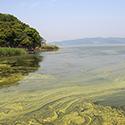 Small Systems with a Big Problem: Harmful Algal Blooms
Small Systems with a Big Problem: Harmful Algal Blooms
Harmful algal blooms are a concern for all water managers, but can be a particularly tough issue to tackle for small systems managers. Responding to these blooms in a timely and efficient manner can make all of the difference in the treatment process. Learn more. (Posted October 27, 2016)
Universities Lend a Hand with Sustainability
Through EPA's Net Zero Initiative, EPA is supporting campus-community partnerships. These partnerships help cities and communities leverage the skills and expertise of local universities to improve sustainability, the health of community members, and the environment. Read more. (Posted October 13, 2016)
Leaving the Gray Behind
Researchers with EPA’s Net Zero Program are working with the U.S. Army, U.S. Army Corps of Engineers, Kansas Unified School District 475, and others to test and demonstrate green infrastructure technology, such as permeable pavement, at Fort Riley in Kansas. Read more. (Posted June 24, 2016)
Linking Air Pollution and Heart Disease
Researchers funded by EPA’s STAR grant program at the University of Washington found a direct link between air pollution and atherosclerosis, which is a buildup of plaque in the coronary artery that can affect heart health. Read more. (Posted June 10, 2016)
Improved Methods for Estimating Chemical Exposure
EPA researchers are using new technology to improve computational exposure science, which helps create a more complete picture of how and in what amounts chemicals enter our bodies. Learn more. (Posted May 17, 2016)
Net Zero: America's Food Waste Problem
Every year in the US, approximately 133 billion pounds of food is wasted. EPA’s Net Zero Initiative is working with communities in Columbia, South Carolina, including military base Fort Jackson, to evaluate ways to reduce the amount of food waste sent to landfills. Learn more. (Posted April 22, 2016)
Net Zero: Leading the Conversation about Sustainability
Under the Net Zero Initiative, EPA is improving the environment, saving money, and helping local communities become more sustainable. Learn more. (Posted April 21, 2016)
National Coastal Condition Assessment
Coastal waters are essential to industry, tourism, recreation, and the lifecycle of various species. This is why it’s so important to monitor these waters for potentially harmful trends and to identify areas in good condition. Learn how EPA scientists assess our coastal waters. (Posted April 19, 2016)







